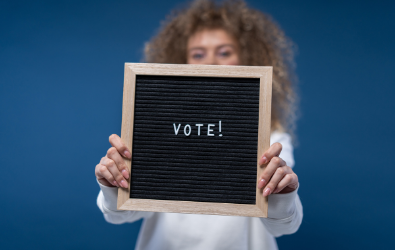Only 58.1% of voting age Americans cast a ballot in the 2016 national presidential election. Huge bipartisan social media efforts are focused on getting people to register and vote in the 2020 presidential election. Celebrities, brands, socially responsible companies, and nonprofits across the United States, are collectively thinking of creative ways to urge people to participate in the election by casting mail in ballots, participating in early in person voting or by going to polling stations on November 3. Here are a few of the most creative and effective social media examples.
National Voter Registration Day
National Voter Registration Day is a single-day, nonpartisan collaborative effort to register voters on the fourth Tuesday of September. This year, on September 29, 2020, the campaign had great success and a high engagement rate motivating voters through virtual events, socially distant voter registration drives, and of course, social media. #NationalVoterRegistrationDay trended #1 on Twitter. According to the press release, more than 4,500 national partner organizations and volunteers came together to register an estimated 1.5 million voters. This momentous achievement is marked as “the largest National Voter Registration Day in history.”
The campaign is not done yet. The day after September 29, the nationwide collaborative effort prompted voters to take the next step after registration and become what they are calling #VoteReady. Election resources and social media toolkits are available on their website aimed at a variety of audiences including, individuals, election offices, and local and national organizations.
#ImVotingFor Campaign
As a tactic to mobilize voters, Joe Biden and Kamala Harris’ campaign launched the #ImForVoting Instagram campaign. Supporters are prompted to post a photo and story about their motivation for choosing their candidate. The reason can be a loved one, local community, economic, social, or environmental justice, state, or federal government matters, etc. This ingenious campaign idea gives voters a personal connection and ties to the political issues they are voting for this year and generations to come.
Next Generation of America
First time Generation Z voters, who may not know all the ins and outs of voting, can turn to social media to find the information they may need on election day. NextGen America has partnered with political affiliations and public figures to increase the number of first-time voters. Another strategy was using a combination of peer-to-peer and broadcast text messages, email, and direct messages on social platforms to make sure that young people have the information and motivation they need to turn out for candidates up and down the ballot. Whether it is Facebook or Instagram, these platforms can guide participants to information about where they need to vote and how to do so using the swipe up features and videos to uplift a voter’s confidence.
With the younger generation becoming more politically involved and paying attention to information on mainstream platforms, social media has proven to be a place for opinion sharing among peers and for emerging media to gain traction and reach new audiences. Despite concerns of misinformation and fake engagement and followers, some organizations remain confident that social media is the best way to reach the broadest audience. When you share on social media, keep in mind the source of information and voting resources. Understanding what to post and how to wrangle reactions and responses to posts will ultimately empower you to build support and a sense of community around the candidate you are voting for in November. It’s more than just getting registered; it’s about having your voice heard and influencing others.


